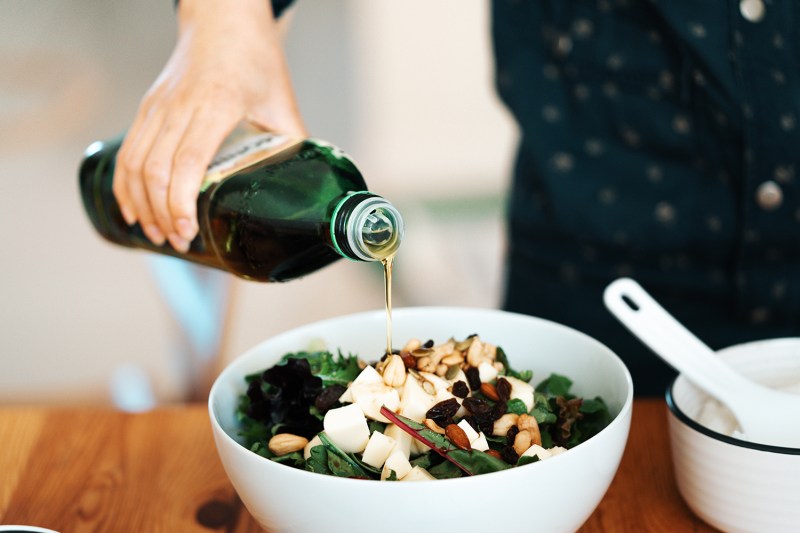
There’s not much good olive oil can’t do. Sure, it’s great on pasta or drizzled over a toasted baguette. But it’s also phenomenal with roasted vegetables, atop pizza, and even as a main feature in your next favorite dessert.
Shoot, if the oil is good enough, it can be enjoyed on its own. Some even believe it has restorative properties and like to apply a little to their skin. You can use it in a good olive oil cocktail or make a bowl of lentil soup with a healthy pour of it. In much of Italy, where olive oil is practically sacred, it’s essentially a healthier substitute for butter. All said, you can count on one hand the dishes that wouldn’t benefit from a little bit of good
Yet, as is the case with anything ubiquitous — pop music, automobiles, fast food, denim jeans — there’s as much or more of the mediocre stuff as there is the high-quality stuff. With so many options, you’d be wise to diversify your oil portfolio, using certain kinds for some kitchen tasks and others for different dishes. And with the holidays right around the corner, you might be after a clever way to gift the olive oil of the culinary gods.

Olive oil top picks
Every soul should experience fresh-pressed olive oil from the spigot in a small town in Italy (or Spain, or Greece, or California, etc.) during harvest. But that fantasy isn’t readily available to all, so here are the best olive oils at the ready here in the States.

Best overall olive oil: Filippo Berio
Berio’s oil hits all the right notes. It’s affordable, widely available, and delivers plenty of finesse and flavor. For a great option without any corresponding fuss, this is your oil.

Best olive oil for finishing: Frantoia Barbera Sicilian Olive Oil
This southern Italian oil is great as a last touch to your favorite dishes and small plates. It’s made from three olive varietals and enhances everything it touches, from fresh bread and cheeses to risotto.

Best olive oil for snacking: La Tourangelle Organic
This oil offers a lot for the price, with a nice peppery element set atop some fresh, grassy flavors. It’s a versatile dipper or topper you can apply to just about anything.

Best olive oil for salads: Brachia
This Croatian offering boasts big fruity flavors and a hint of spice. Translation: It’s all you really need to dress up a good salad, give or take a little cheese, and some salt and pepper.

Best olive oil to buy in bulk: Mr. Papou’s Extra Virgin Olive Oil
This offering from Greece comes in a 3-liter tin and is certified extra virgin. It’s balanced and great in a variety of dishes, making having quite a bit of it on hand quite sensible.

Best olive oil for frying: 365 Cold-Pressed Mediterranean Blend
You don’t have to go with Canola oil just because you’re frying. You can still use a good olive oil, like this one from Whole Foods. It comes in at an extremely friendly price while still offering a lot of pleasant characteristics.

Best cold-pressed olive oil: California Olive Ranch Arbequina
Cold-pressed is a popular means of making oil and essentially just means that the oil never exceeds a certain temperature (around 80 degrees Fahrenheit) in the name of holding on to flavor compounds and purity of character. This one is one of the best in the large category, made from the tasty arbequina olive and showing vibrant fruit notes.

Best flavored olive oil: Saratoga Basil-Infused Olive Oil
There are lots of great olive oil infusions, not to mention a whole separate and delightful world of truffle oils. This basil-charged oil from Vermont olives is vibrant and great atop all of your favorite Italian dishes.

Best luxury olive oil: Pamako Monovarietal Mountain Organic
This Greek oil comes in a fetching bottle and delivers colossal flavors and aromatics. Better still, it’s as smooth as satin, certified organic, and something you won’t feel the least bit guilty about when spending a little more loot.

Homemade dressing with olive oil recipe
Making your own dressing is a healthy way to go, especially a salad dressing with an olive oil base. Here’s a simple recipe to make your own dressing with extra virgin
Ingredients
- 3 tablespoons extra virgin olive oil
- 1 tablespoon vinegar (balsamic, red wine, white wine, or lemon juice all work well)
- 1 small garlic clove, minced (or 1/2 teaspoon garlic powder)
- 1 teaspoon Dijon mustard
- 1/2 teaspoon sea salt
- 1/4 teaspoon freshly cracked black pepper
Method
- In a small jar or container with a tight-fitting lid, whisk together all ingredients.
- Taste and adjust seasonings as desired. You can add more vinegar for tang, more salt for savoriness, or a touch of honey or maple syrup for sweetness.
Here are some tips for customizing your DIY dressing:
- Herbs: Add a tablespoon or two of chopped fresh herbs like parsley, basil, oregano, or thyme for a fresh flavor boost.
- Cheese: For a creamy texture, whisk in a tablespoon of grated Parmesan cheese or crumbled feta.
- Spice: Add a pinch of red pepper flakes for a kick.


